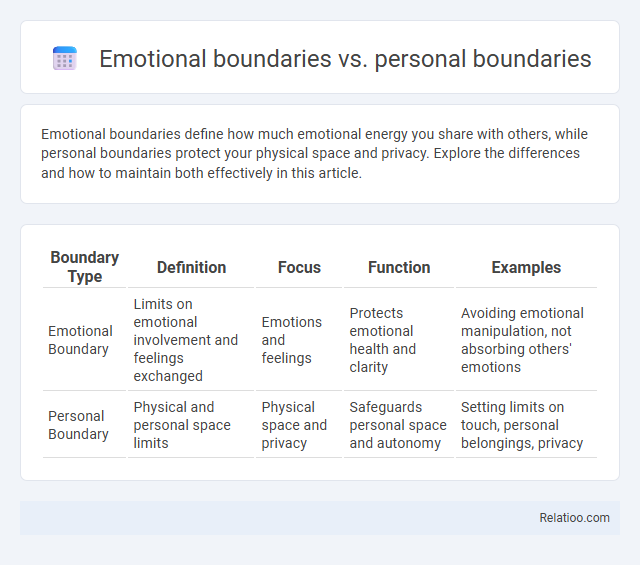Emotional boundaries define how much emotional energy you share with others, while personal boundaries protect your physical space and privacy. Explore the differences and how to maintain both effectively in this article.
Table of Comparison
| Boundary Type | Definition | Focus | Function | Examples |
|---|---|---|---|---|
| Emotional Boundary | Limits on emotional involvement and feelings exchanged | Emotions and feelings | Protects emotional health and clarity | Avoiding emotional manipulation, not absorbing others' emotions |
| Personal Boundary | Physical and personal space limits | Physical space and privacy | Safeguards personal space and autonomy | Setting limits on touch, personal belongings, privacy |
Understanding Emotional Boundaries
Emotional boundaries define your ability to separate your feelings from others' emotions, ensuring your emotional well-being remains intact. Personal boundaries, on the other hand, encompass physical space, privacy, and personal limits beyond emotions. Understanding emotional boundaries helps you recognize when to protect your feelings, avoid emotional overload, and maintain healthy relationships by clearly distinguishing your emotions from those of others.
Defining Personal Boundaries
Personal boundaries define the limits that protect your physical, emotional, and mental space from being invaded by others, ensuring your sense of autonomy and well-being. Unlike emotional boundaries, which specifically regulate how much emotional energy you share or absorb, personal boundaries encompass a broader scope including physical space, privacy, and individual values. Understanding and establishing clear personal boundaries helps maintain healthy relationships by communicating your needs and limits effectively.
Key Differences Between Emotional and Personal Boundaries
Emotional boundaries regulate how much emotional energy is shared or absorbed between individuals, protecting personal feelings from being overwhelmed, while personal boundaries define physical, mental, and social limits that preserve individual space and autonomy. Key differences between emotional and personal boundaries lie in their focus: emotional boundaries safeguard internal emotional well-being, whereas personal boundaries encompass both emotional and physical aspects of interaction. Maintaining clear emotional boundaries prevents emotional exhaustion and enmeshment, while personal boundaries ensure respect for one's privacy, physical space, and personal needs.
Why Emotional Boundaries Matter
Emotional boundaries protect an individual's feelings and mental health by defining where their emotions end and another's begin, preventing emotional burnout and codependency. Personal boundaries encompass a broader range of limits, including physical space, privacy, and time, essential for maintaining overall well-being and self-respect. Prioritizing emotional boundaries fosters healthier relationships by ensuring emotional autonomy and reducing stress caused by emotional manipulation or over-involvement.
Importance of Personal Boundaries for Well-being
Personal boundaries define the limits that protect an individual's physical and emotional space, crucial for maintaining mental health and preventing burnout. Emotional boundaries specifically regulate exposure to others' feelings, enabling healthy relationships without emotional exhaustion. Prioritizing these boundaries supports overall well-being by fostering self-respect, reducing stress, and enhancing emotional resilience.
Signs of Weak Emotional Boundaries
Weak emotional boundaries manifest through signs like oversharing personal feelings, difficulty saying no to emotional demands, and feeling overwhelmed by others' emotions. Personal boundaries involve limits on physical space and personal time, while emotional boundaries regulate your feelings and protect your emotional well-being. Strengthening your emotional boundaries helps maintain mental health by preventing emotional exhaustion and maintaining self-identity.
Identifying Breaches in Personal Boundaries
Personal boundaries define limits around physical space, time, and privacy, while emotional boundaries protect feelings and internal emotional experiences; identifying breaches involves recognizing discomfort when these limits are crossed. Emotional boundary intrusions often manifest as undue influence on one's feelings or ignoring emotional needs, whereas physical or personal boundary violations include unwanted physical contact or overstepping privacy. Awareness of these distinctions enables individuals to assert themselves clearly and maintain healthy relationships by addressing boundary breaches promptly.
How to Set Healthy Emotional Boundaries
Setting healthy emotional boundaries involves recognizing and respecting your own feelings while clearly communicating your limits to others. Personal boundaries protect your physical space and privacy, whereas emotional boundaries safeguard your mental and emotional well-being by preventing others from manipulating or overwhelming you. Practical steps include identifying your emotional limits, practicing assertive communication, and consistently reinforcing these boundaries to maintain respectful and balanced relationships.
Strengthening Your Personal Boundaries
Strengthening your personal boundaries involves recognizing and respecting both emotional and physical limits to maintain mental well-being and healthy relationships. Emotional boundaries protect your feelings from being overwhelmed or manipulated, while personal boundaries define your comfort zones regarding physical space and social interactions. By clearly communicating your needs and enforcing these limits, you empower yourself to uphold respect and foster healthier, more balanced connections.
Balancing Emotional and Personal Boundaries in Relationships
Balancing emotional and personal boundaries in relationships involves recognizing the distinct roles each plays in maintaining healthy connections. Emotional boundaries protect your inner feelings and prevent emotional enmeshment, while personal boundaries define your physical space and individual limits in interactions. You can foster mutual respect and trust by clearly communicating these boundaries, ensuring emotional needs are met without compromising personal autonomy.

Infographic: Emotional boundary vs Personal boundary
 relatioo.com
relatioo.com